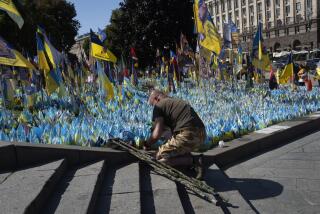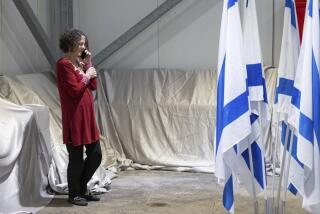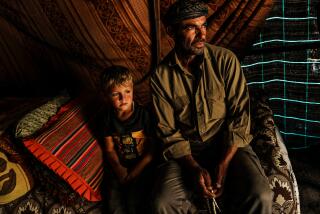Crowds Cheer Liberation Day in Kuwait City
KUWAIT CITY — Kuwait’s liberation army paraded into the nation’s capital Wednesday on rumbling chariots of armor as thousands of cheering, chanting Kuwaitis poured into the streets in celebration.
“Blood for Freedom: Welcome Allied Forces,” read a banner draped over the main highway into Kuwait, which was choked by midday with dozens of allied tanks, supply trucks and a honking stream of Mercedes-Benzes, BMWs and Chevrolets in a city come suddenly to life after seven months of occupation.
“We are very happy today. We thank all of you who helped by feeling, by military, by your heart,” said Khalid Matrouk, a 26-year-old banker. “We waited too much for this day to come.”
In a city apparently savaged by Iraqi occupiers, where the formerly gleaming, urbane cityscape nurtured by Kuwait’s fabled petroleum riches has become a broken landscape of devastation, the throaty grumbling of tanks and gun trucks shortly after dawn brought a fearful populace out of hiding after months behind closed shutters and locked doors.
“They came with apples,” aging jeweler Said Esbaitah said with wonder. “Apples. Lebanese apples. Not without food, like the Iraqis. These troops came with fresh apples, fresh bread. See the difference between the international troops and the Iraqi troops! The Iraqi troops came and took our food. These troops came with Lebanese apples!”
Women dressed in traditional black robes joined hands and lined the streets, trilling the traditional ululation that is the Arab woman’s sound of joy. Two women wore Kuwaiti flags draped across their faces in place of veils, and dozens of young men marched through the backed-up parade, exuberantly firing rifles into the air. A car cruised by with a tambourine waving out the window.
“Good, good, good, good Bush!” shouted a grinning young Kuwaiti boy, dangling out a car window.
Convoys of cars and trucks honked horns and waved Kuwaiti flags. Two men in a Chevrolet pickup festooned with flags and posters of Kuwait’s exiled emir, Sheik Jabbar al Ahmed al Sabah, sped by to shout “Thank you very much! Thank you!” as children clapped and cheered and waved from the back.
As a prelude to asserting control over the capital, Kuwaiti forces hoisted the red, white, black and green Kuwaiti national banner atop Safat Square within hours after U.S. Marines and Saudi, Egyptian and Syrian forces had secured positions around the perimeter of the capital.
Troops of the 1st Marine Division had been the first to enter Kuwait city on Tuesday afternoon, followed soon thereafter by Kuwaiti soldiers. The Marines reached the capital after a daylong advance from positions in central Kuwait about 50 miles away. By the following day, the last of the fighting around the capital appeared over.
On Wednesday, both U.S. Marines and Kuwaiti troops were being joyously welcomed by those in the city.
“I’ll keep that memory forever,” said Lt. Gen. Walt E. Boomer, who led the Marine convoy into the city after his troops completed the capture of the international airport.
Added Staff Sgt. Anthony Tavarone: “You couldn’t pay for this.”
Yet, the city liberated Wednesday bore chilling reminders of the furious destruction that has been visited on the tiny oil emirate since Iraqi President Saddam Hussein’s forces moved in on Aug. 2.
Although the Kuwaiti capital rattled with jubilation throughout the day, after dark it was a frightening, silent fortress, its looted skyscrapers looming starkly over a moonless landscape in a city that has been without steady water, electricity or telephones for weeks. A fire from one of hundreds of oil wells set ablaze turned the southern night sky an eerie orange. The exiled emir’s Dasman Palace stood in a pile of ruins along the sweeping corniche.
At least 15 bombed or abandoned Iraqi tanks littered highways leading to the city, as well as scores of burned-out light armored vehicles and trucks. At least two tanks were seen with their turrets blown off by direct hits.
“Every Kuwaiti man, they hope to catch Saddam and to kill Saddam,” the banker Matrouk said quietly.
Kuwaiti resistance members said they had taken control of police stations throughout the city and were holding more than 2,000 Iraqi prisoners, captured during the Iraqi army’s unexpected dash out of the city.
“They were very afraid. Some of them entered the houses. They were very scared, and some of them, they surrendered to us,” said Emad Ban, a 24-year-old resistance leader, who said he personally took into custody earlier Wednesday an Iraqi soldier wearing civilian clothing.
“I was driving my car, and I saw an Iraqi in a car whom I recognized,” he said. “I tell him, ‘Stop, stop, stop!’ and I put a gun in his face. He says, ‘I’m a Syrian,’ but I say, ‘I know you.’ And he surrendered to me.”
In the four days before their retreat from the Kuwaiti capital, Iraqi forces seized an estimated 2,000 to 3,000 Kuwaitis who had been held in Kuwait city’s Fordoos Prison, and most are believed to have been taken to Iraq, Ban said. Officials here believe that Iraq intends to use the captives as hostages to improve Iraq’s bargaining position in determining how quickly U.N. resolutions are to be applied after the withdrawal.
Iraqi soldiers Friday abducted males between the ages of 15 and 60 from the Shewayeb Mosque outside Kuwait city, according to Khalil Abdulaziz, 26, a welder in an oil plant. Abdulaziz said Iraqi troops suddenly blocked the mosque’s four exits and ordered about 100 Kuwaitis onto buses at gunpoint.
“They come with guns,” he said. “My friend, his brother they catch. Then, they come take everybody (in) his house. Three children. Only 3 month (old), little one. Now gone.”
Ibrahim Rashid said four Iraqi soldiers approached him a few days ago and ordered him to accompany them. “I said, please, I don’t do anything, and I kiss them. What can I do? I was lucky.
“This (occupation) was seven months,” he said, “but each day like one year, swear to God. All my hairs are gray.”
Chilling tales of brutal killings over the last several weeks are circulating through the Kuwaiti capital. In one account, an Iraqi soldier who had apparently displeased his superiors was shot in both legs and then clubbed to death over the head, his body left in a residential neighborhood, one man reported.
A resistance leader said he saw the body of a 6-year-old girl who had been kidnaped for several days by Iraqi soldiers, then returned when her father gave the soldiers a car and made a sizable ransom payment. As the girl was dropped off to her parents, the soldiers fired a bullet into her forehead, killing her, he reported.
Faisal Bahman, a biomedical technician, said soldiers “killed most of the patients and threw them in the streets” at the 360-bed Adan Hospital in the four days before the Iraqis hurriedly retreated Tuesday.
“They grabbed hands to the back, then put something on the eyes, and with a pistol they shoot them in the head,” Bahman said.
“They (Iraqis) say they are Kuwaiti resistance,” he added. “I don’t know how a 12-year-old kid is Kuwaiti resistance. But they killed him.”
Bahman, 33, said armed Iraqi troops also abducted all the male worshipers from the Riqa Mosque after prayers last Friday, including two of his brothers-in-law and two cousins.
“We don’t know if they are alive or dead,” he said. “We don’t know if they are in Iraq or where.”
Scattered sniper incidents were reported in parts of the city, but U.S. officials said the remainder of the capital was under allied control. Britain’s ambassador was reportedly planning to reopen the British Embassy today, and U.S. officials were considering a similar move at the American Embassy.
The liberation began shortly after midnight Monday when Iraqi soldiers are said to have launched a sudden, extremely rapid retreat from the city, in many cases dropping their weapons and grabbing civilian cars in a panicked rush to move back north to Iraq.
One woman said Iraqi soldiers came to her house and demanded the mini-truck parked outside. When she said it wouldn’t start, they left, then returned an hour later and hot-wired the vehicle.
Blown-up and charred Iraqi tanks and trucks littered the main highway, with stolen clothing, food and other last-minute spoils littering the streets.
Resistance leaders said allied military forces have visited police precincts to obtain a count of Iraqi prisoners but have left them in Kuwaiti custody for the time being. The resistance has clearly undergone a substantial revival over the last several days after months of inactivity spurred by violent Iraqi retributions against resistance leaders, their families and neighbors.
In the days before Saddam Hussein’s withdrawal order, resistance leaders began wearing magenta silk armbands over their dark winter robes, and regular members wore pink armbands.
It was a secret signal to resistance leaders to end their months of hiding and begin organizing on a neighborhood-by-neighborhood basis--this time not to mount attacks against occupation forces but to help facilitate their retreat from the city and maintain law and order until Kuwait’s exiled government can return.
Sheik Jabbar, from his exile headquarters in Saudi Arabia, has declared a three-month period of martial law until basic services can be restored. The crown prince, Sheik Saad al Abdullah al Sabah, could return to Kuwait city as early as next week.
Bahman, the medical technician, said Kuwaitis would never forget America for its help. He pointed to the Persian Gulf, a few hundred yards away.
“Even if this sea is all ink, we can’t write enough thank-yous to President Bush and the American people,” he said. “Thank you! Thank you!”
INSIDE KUWAIT CITY
Kuwait City was declared officially liberated after troops of the 1st Marine Division captured Kuwait International Airport early Wednesday, apparently ending organized Iraqi resistance in the city. But the once-prosperous capital bore the scars of nearly seven months of occupation:
1. Five-story Interior Ministry building was gutted and blackened, along with numerous other government buildings.
2. Power lines were down and there was very little water. Hundreds of buildings were fire-damaged or gouged by shellfire. Many structures were stripped of food and fittings; others were ransacked and boobytrapped. Streets were full of abandoned tanks, personnel carriers and antiaircraft guns.
3. The main road from Saudi Arabia was nearly intact, but littered with charred hulks of tanks.
4. Huge fires blazed at oil installations on city’s outskirts.
5. The exiled emir’s Dasman Palace was in ruins.
6. Seafront hotels were torched; at Kuwait International Hotel, much of furniture was reduced to a pile of junk.
7. Rocket attack left a gaping hole in the city’s main landmark, an obelisk-like structure on waterfront.
8. In downtown Safat Square--traditional site of National Day celebrations--Kuwait troops hoisted the country’s colors.
More to Read
Sign up for Essential California
The most important California stories and recommendations in your inbox every morning.
You may occasionally receive promotional content from the Los Angeles Times.











